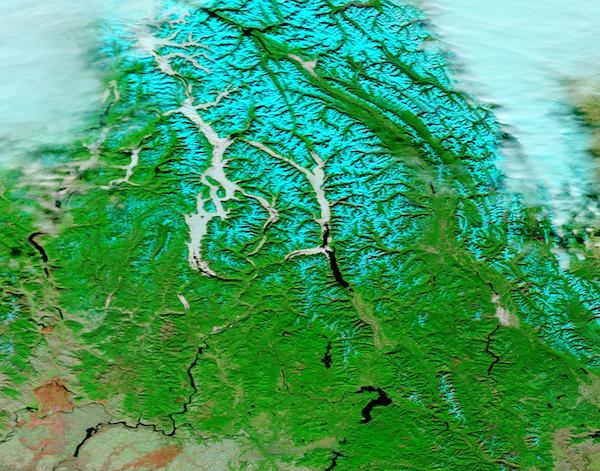Images
November 6, 2020 - Fog in the Canadian Rockies
Tweet
As autumn nights lengthen and cool weather settles over the mountains, the chances of valleys filling with evening fog increase. In the long night, the atmosphere has more time to cool down and approach the dew point—the temperature at which the air becomes saturated and water vapor condenses into fog. Since cold air is denser than warm air, it sinks into low-lying valleys, meaning fog develops there first, while the higher mountain peaks remain in clear air. When valleys are filled with rivers, streams, or lakes, the process is amplified as these features provide a ready supply of water vapor.
On November 2, 2020, the Moderate Resolution Imaging Spectroradiometer (MODIS) on board NASA’s Terra satellite acquired a false-color image of valley fog in British Columbia, Canada. This false-color image uses a combination of visible and infrared light to make it easier to distinguish between snow, fog, and cloud—all of which appear white in true-color images. In this combination, snow appears bright cyan, fog (low cloud) appears white, and higher, colder cloud appears pale cyan. The heaviest fog appears over lakes, including Upper Arrow Lake (east) and Okanagan Lake (west).
Image Facts
Satellite:
Terra
Date Acquired: 11/2/2020
Resolutions:
1km (110.5 KB), 500m (366.1 KB), 250m (1 MB)
Bands Used: 7,2,1
Image Credit:
MODIS Land Rapid Response Team, NASA GSFC
Tweet
As autumn nights lengthen and cool weather settles over the mountains, the chances of valleys filling with evening fog increase. In the long night, the atmosphere has more time to cool down and approach the dew point—the temperature at which the air becomes saturated and water vapor condenses into fog. Since cold air is denser than warm air, it sinks into low-lying valleys, meaning fog develops there first, while the higher mountain peaks remain in clear air. When valleys are filled with rivers, streams, or lakes, the process is amplified as these features provide a ready supply of water vapor.
On November 2, 2020, the Moderate Resolution Imaging Spectroradiometer (MODIS) on board NASA’s Terra satellite acquired a false-color image of valley fog in British Columbia, Canada. This false-color image uses a combination of visible and infrared light to make it easier to distinguish between snow, fog, and cloud—all of which appear white in true-color images. In this combination, snow appears bright cyan, fog (low cloud) appears white, and higher, colder cloud appears pale cyan. The heaviest fog appears over lakes, including Upper Arrow Lake (east) and Okanagan Lake (west).
Image Facts
Satellite:
Terra
Date Acquired: 11/2/2020
Resolutions:
1km (110.5 KB), 500m (366.1 KB), 250m (1 MB)
Bands Used: 7,2,1
Image Credit:
MODIS Land Rapid Response Team, NASA GSFC




